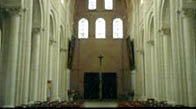The ferocious resolution of the English struck terror into the foot-soldiers
The tactic was a great success. Again and again, the Norman knights hurled themselves against the English shields, but as the Bayeux tapestry shows, they were unable to make any headway. Then, on the Norman left, the Bretons under Count Alan began to give way. Orderic Vitalis takes up the story:
'The ferocious resolution of the English struck terror into the foot-soldiers and knights of the Bretons and other auxiliaries on the left wing; they turned to flee and almost the whole of the Duke's battle line fell back, for the rumour spread that he had been killed. But the Duke, seeing a great part of the opposing army springing forwards to pursue his men, met them as they fled, threatening and striking them with his spear.
'Baring his head and lifting his helmet he cried: "Look at me, I'm alive and with the aid of God I will gain the victory!" No sooner had the Duke spoken these brave words than their failing courage was restored, and surrounding several thousand of their pursuers, they mowed them down almost at once.'
It was the turning point of the battle.
The whole incident is portrayed on the Bayeux tapestry. It was the turning point of the battle. Now the English wall had broken, and the Normans were able to lever open the cracks. Exhaustion and weight of numbers also took their toll. Gyrth and Leofwine, the two remaining brothers of Harold are depicted being cut down on the tapestry, and Harold was soon to follow.
We see him on the Bayeux tapestry taking an arrow in the eye and then being ridden down by a Norman cavalryman, one of four who managed to break through the English line and trample Harold into the ground. Though the English still fought on bravely after their king had fallen, their cause was lost, and eventually they fled into the night.
The body of Harold was eventually recovered...
Tradition has it that William gave thanks to God for his victory and ordered that all in his army should do penance for the souls that they had killed that day. He himself paid for the foundation of Battle Abbey on the spot where Harold fell.
The body of Harold was eventually recovered after a long search, but its face was so badly disfigured that they had to bring it to his concubine, Edith Swan-neck, to identify by the intimate marks upon his body. Initially, William had the body buried next to the battlefield, with a headstone reading, 'Here lies Harold, King of the English', but after Harold's name was blackened by later Norman propaganda, the headstone was removed, and the body was disinterred and taken to Harold's abbey at Waltham.
Top
King William
 The Abbé-aux-Dames, where William prayed before embarking for England © The contest for England was not yet over, however. William kept his army in Hastings for about a week, then he marched through south-eastern England, via Dover and Canterbury, to London Bridge.
The Abbé-aux-Dames, where William prayed before embarking for England © The contest for England was not yet over, however. William kept his army in Hastings for about a week, then he marched through south-eastern England, via Dover and Canterbury, to London Bridge.
Finding this too heavily defended, he continued along the southern bank of the Thames to Wallingford, sending a detachment to take Winchester on the way. Wallingford was the easternmost ford of the Thames, and was defended by an ancient Anglo-Saxon burh (a fortified town) under the command of the king's thegn Wigot of Wallingford.
By now it was December, and the long campaign had sapped the English will to resist. Dover and Southwark had been razed to the ground, and William now had control of Canterbury, the religious centre of England, and Winchester, the ceremonial seat of the English kings.
At Wallingford, the first English submissions occurred. Archbishop Stigand of Canterbury led a delegation of important English bishops and thegns, who surrendered to William, and Wigot opened the gates of Wallingford to him. By Christmas, the earls Edwin, Morcar and Waltheof, along with Archbishop Ealdred of York, had also surrendered, having ensured that their positions would be secure under the new régime.